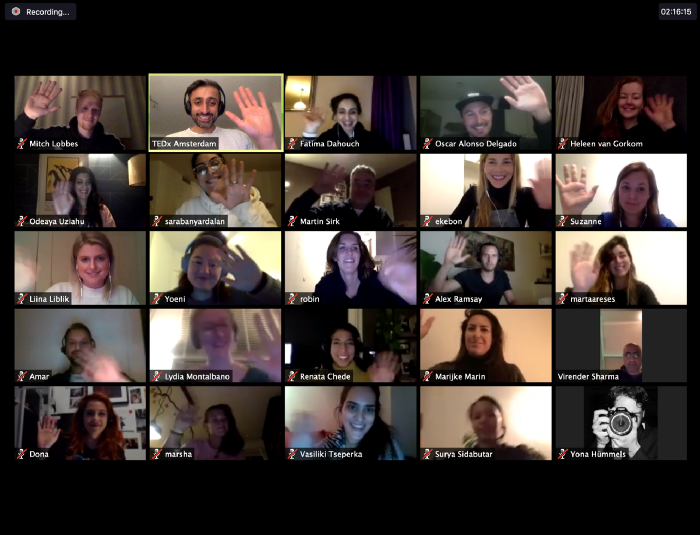12 tips for hosting online meetings
Summary: here are some essential tips while hosting, guiding and facilitating online sessions. Whether it is a meeting, a workshop or a more open session, these tips provide a strong basis and some essential matters to keep in mind.

First, let me get into some background with regards to the path I took getting to these specific insights, after which I will get into two divisions of tips.
Tips 1–5 are more about setup and setting.
Tips 6–12 are about the hosting methodology and facilitation.
A little background

Me and Technology
Shortly after starting university, my first part-time job was working at an electronics store at Schiphol, the Amsterdam International Airport. Being a bit of a technological geek, I loved playing around with the newest gadgets on the market. When the first colour screen mobile phones came out, I would take the entire day to learn whatever I could about them. I would put my sim card in the phone and try everything out, learning everything I could. My interests in technology varied from software to hardware. I loved to open my laptop and learn to replace every part of it myself. I remember replacing the battery, hard drive, motherboard and even the screen of my first MacBook. The technology of a particular time era has always been something that fascinates me. I continued my passion for studying medicine and eventually, with some deviant twists and turns, became a consultant that helps other organisations become a force for good for the world. Until today though, I still follow new trends and continue to learn about different kinds of developments in hardware and software. At Better Future, I have the not so official title of being the “technical support :P”, which my teammates also make jokes about.
Software and online media
When I was transitioning from being a med student to becoming a full-time strategist and consultant, I started a company with a friend and fellow trainer, which helped companies bridge the offline to online. This bridging meant learning how to use online platforms for both internal and external purposes within organisations. Around 2010, a time where Social Media was growing at a staggering speed, we were at the forefront of large platforms such as Facebook, Twitter, Instagram and LinkedIn. I especially loved the combination of knowing how these platforms worked, while also the skill to guide and consult for people to show them how they should use it themselves and share their story online.
Facilitation and consultancy
Shortly after starting university, I became active in an international medical student association (IFMSA), where I would learn to become a “trainer”. Being a trainer entailed learning to teach and guide others to learn a new skill and personally develop themselves. I remember the immortal words I learned
“You teach that which you wish to learn the most”
And I wanted to know everything there was to know about leadership, personal development, project management, facilitation, coaching, teamwork, and most of all, how to create change.
What followed was thousands of working hours setting up leadership summer schools, TEDx events and healthcare leadership initiatives to help and guide others to become “the change the world needs”. Who would have known that years later, the thing I loved to do as a med student, would be the very thing I would be doing professionally?
Online meetings
Back in 2005, Skype was pretty much the only multi-person online calling platform that we had. Google hangout shortly followed, but many people didn’t have a Google account which made it annoying to use. We didn’t have any other alternatives, so we learned how to use Skype with all its limitations with large group international calls. Fast forward 15 years, and we can see an explosion of platforms that are now used, such as Zoom, MS Teams, Vectera and the further development of Skype and Skype for business. And although the tools have changed, the fact that we meet online, with different people, internationally, with varying internet connections and time zones, hasn’t changed at all.
Having the chance to practice and work with online meetings for many years now, and having tested and tried most platforms, I realised there are particular methodologies to keep a part of the magic one does when attending a physical meeting.
Ready to get into the tips?

Tip 1: Know your platforms
Put your geek hat on and learn how each one of these tools works. Go to youtube, find tutorials, and take time to learn about all the settings and buttons. Only till late did I learn that Zoom has a “breakout session” function.
My mind blew! These breakout sessions are the literal translation of having a group of people in a big room, and then asking them to go into small physical break out rooms to discuss a specific question or query with fewer people, and then bringing them all back to the “main room” when they have had enough time. So yes, it pays to invest some time to go through the functions of such platforms. What may seem the boring manuals and instructions can make a huge difference in hosting and understanding what the possibilities are.
Tip 2: Prepare the session
Preparation may be a no-brainer, but I see many people enter an online meeting, as they would an offline one, unprepared. If it is hard to keep people’s attention when you meet physically, it is even harder to do so when you are online. Realise people are at home, with distractions all around them. What you can keep in mind while preparing is, amongst others;
- Do you have a clear plan?
- What do you want as an outcome of this meetup?
- Know who is attending?
- Does everyone have access and awareness of how to get on the online platform in advance?
- Is there someone who can make notes, or are you set up to do so yourself?
In a time where things are fast-paced, this can save at least 10 minutes with each meeting. Preparation is key and often overlooked. Have all the fundamentals set up and it can help in having much smoother and effective meetings.
Tip 3: Have enough time planned
First, ask yourself how long you need to have a productive outcome? I have hosted online sessions from 15 minutes to four hours long because I knew that this how much time I needed. There is a notion that calls should be shorter because we cut the pleasantries and get straight to business. Going from call to call can be pretty exhausting, but do plan enough time for people to check-in, connect and then dive into the subject matter. It helps to make sure that after the body of the topic is discussed, you have enough time to wrap things up without it feeling rushed.
So a 1-hour session is realistically a 40-minute session which can look a little like this
- 5–10 minutes to check-in and start
- 40 minutes of meeting and working
- 5 minutes to wrap and round up
- And not to forget 5 minutes to go to the bathroom and grab some water before your next call (which many of us can forget)
Closing the meeting off with time to spare is often more of a relief than to have to rush and cut things off. I even like to use the “extra” time before my next call to start looking through my notes and have my follow up actions set. So having enough time planned is for everyone, which keeps things at a gentle pace instead of feeling rushed.
Tip 4: Know which questions you want to ask
To keep an online session interactive, have your specific questions prepared and ready. Test these questions with either your team or with someone you trust beforehand. It helps to spar thoughts and experiment since, in large online meetups, some issues are not easily understood or answered. Try thinking about open questions that give everyone a chance to think, reflect and share. An example is what we do during our Monday morning “coffee corner’s” at Better Future. One of the questions we asked people was:
“what is one insight about last week you would like to share?”
This question is both open and helps you reflect. It is also great to hear this from others and you can learn a lot from each other.
Tip 5: Check your desk/office setup + software.
As you would set up a workshop room before you host a session with live participants, set up your desk and office to make sure your earphones are plugged in or Bluetooth is connected. If your headphones need charging, make sure you’ve done that in advance too. Check the lighting; sometimes people have the sun behind them, meaning all one can see is a silhouette. Jump into the “preferences” so you can test the camera and see what others see, as well as try out the audio. See if you have enough battery or do you need to plug yourself into an electrical socket? I have a few places I can do calls in the house, even a makeshift standing desk if sitting becomes tiresome, but these are things I need to set up and prepare in advance. I also have a pot of tea ready, or glass of water, as it is harder to do so while in the middle of a meetup. The important part is to be prepared at least 15 minutes before you start.
When I physically receive participants in a room, I often have one of my favourite Spotify music playlists playing in the background to get people in a different mental mood. As Zoom is my preferred calling online platform to use, one functionality I learned and love is “playing sound from your computer” so that others hear the same music playing. This functionality is a beautiful way to have people enter the call with a nice intro and getting them all in a different vibe. This functionality is especially appreciated when we had Thursday afternoon drinks online, and I would crank up the music then to some lounge up-tempo hits that we can unwind to together.
Now let’s get to the hosting and facilitation part of things

Tip 6: Welcome people in the meeting space
Find a way to welcome people that have entered and logged in to the call. Most platforms have a function that plays a noise (a dong) with each person registering. Knowing who will be attending also helps with welcoming each person and double checking if they are set up and ready to start. The one advantage that this entire corona phase has given is that it is now hard to find one person that does not know how to access online meeting platforms. But even still, make sure that each person is welcomed. See if you can double-check that both mic and video are working properly.
If I see a beautiful painting or something else in the background, I often comment on my observations. This kind of feedback can help to break the ice and more so realise that we all are in our own environments, be it our home desk, living room, garage, office or wherever else. It is nice to acknowledge this and to make a note which physical space each person is checking in from.
Tip 7: Starting and setting up the ground rules
Kick off the meeting and start by welcoming everyone. It helps to appreciate everyone for being present and that they are on time. Layout the rules of procedure, so it is clear how the meeting will go and what to keep in mind. As you would in a physical setting, tell the people who are attending and what they can expect. The things I try including during such an introduction is how the flow of the agenda will go when we will break in small groups and when we can take a short (bio) break. If you want to use the chat function for people to ask questions or “put up their hands”, make sure this is established up front. Knowing which functions to use is also a matter of preparing, but it can even help to ask everyone “what would help make this time we have more productive?”
Tip 8: Use the chat function
Every online call program has someplace where you can write down text. This place is a goldmine if you ask me when it comes to gathering input. For our low threshold online “coffee corners” I would ask each person what they are eating or drinking in the morning, and to type that up in the chat so we all can read it. As silly as this can sound, it helps since everyone can write something for themselves and each person learns how to use the chat while also being connected via video. That kind of multitasking takes some getting used to, but it is pretty damn handy.
I use this function when I ask attendees first to share it in the chat. Once shared in the chat in text form, it becomes more comfortable to ask to share verbally, and it also means I now have both kinds of input.
Tip 9: Ask a question, pause, and gather input
So this is key when it comes to gathering input from a group of people and making it interactive.
First, have your question ready. Make sure it is clear, something that is relatively easy to answer, the wording is key. Once you have asked, pause for people to write down their answers. When they have written their response, you can observe and see if everyone understood what you asked and if you need to explain anymore.
What I often do is ask people to write it down in the chat once they are done, so you can easily keep track who is done and who isn’t. If this doesn’t suit the setting, ask people to put a thumbs up once they are done so you know when most are done and then ask them to share verbally. Whatever it is, but having some sign that the question has been answered helps in gathering input and knowing who is involved.
Tip 10: Listen, summarise, share, move on
Whenever someone shares their response to a question, instead of saying “thank you, next!”, I first summarise a part of their answer and try to give an anecdote of what it that it made me think of. The summarising keeps me engaged with what I hear, but also helps connect more to what is being shared. I am the host/facilitator, and yet I am also a human being listening to another human being. Use that as a means to relate. Research on reciprocity shows that feeling understood helps group cohesion, so use it functionally, especially when guiding online meetups.
Tip 11: Keep it interactive
What is important here is the questions you ask and how you engage people.
Holding longer online meetups means you need moments in between that people are given something to do. The ways I keep people engaged is by asking them to write something down, share it in the chat, hold break out rooms and having a chance to really connect with a smaller group of people.
Think about how you would do this if you were physically in a room with the same people, what would you ask them? How would you activate them all? What questions would you ask? What are things that are relevant to share, and what would others really like to hear about?
Tip 12: Closing and wrapping up
Because I am behind my laptop, I can always see the time, which in this case has its advantage. I make sure that I am mindful for the blocked time in everyone’s agenda that everyone has made for this. Most people have planned their day to the dot, which means, if the time is done, people start logging off the second the clock strikes. So make sure you have enough time to wrap things up, summarise, ask for last inputs and then to close. I often keep a list of things I want to say before we close, and have enough time to say them and wrap things up in a calm manner. When making the last round, I have realised how there is often something that someone wants to say, which takes more time than I had anticipated.
Bonus Tip 13: Take a picture

We are social beings, in the end, so seeing us connected while physically not in the same space gives us a feeling that we are in this together. Using the handy “command + shift + 3” function (on a Mac), I often ask everyone to wave while I take a screenshot. Instead of taking one while everyone has weird facial expression mid-meeting, it helps to prepare everyone.
And I know, the number of Zoom screenshots are becoming oversaturated. Yet it remains a nice social reminder of coming together.
Final words

Hosting online meetings is a delicate dance between knowing how technology works and realising how people work. It is about knowing how to host, facilitate and guide while knowing how to use online meeting programs to the best of their capacity. If you can learn to adapt them to your needs, it becomes even more natural, and more fun to do so.
Subscribe to Newsletter